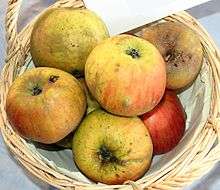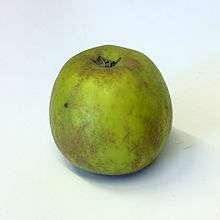Ribston Pippin
'Ribston Pippin' is a triploid cultivar of apples, also known by other names including 'Essex Pippin', 'Beautiful Pippin', 'Formosa', 'Glory of York', 'Ribstone', 'Rockhill's Russet', 'Travers', and 'Travers's Reinette'.[1]

Origin
This apple was grown in 1708 from one of three apple pips sent from Normandy to Sir Henry Goodricke of Ribston Hall at Little Ribston near Knaresborough, Yorkshire; the original trunk did not die until 1835. It then sent up a new shoot and, on the same root, lived until 1928.

The 'Ribston Pippin' is one of the possible parents of 'Cox's Orange Pippin'.
Description
The apple skin is a yellow, flushed orange, streaked red with russet at the base and apex. The yellow flesh is firm, fine-grained, and sweet with a pear taste. Irregularly shaped and sometimes lopsided, the apple is usually round to conical in shape and flattened at the base with distinct ribbing. Weather conditions during ripening cause a marbling or water coring of the flesh, and in very hot weather, the fruit will ripen prematurely.
Culture
A vigorous tree with upright growth, its medium-sized ovate to oval-shaped leaves are a deep green color and distinctly folded with sharp, regular, and shallow serrations. The surface of the leaf is smooth and dull with a heavy pubescence.
It is very slow to begin bearing, and the proper pollinators will increase the fruitfulness. 'Lord Lambourne' has been recommended for a pollinator, as well as 'Adam's Pearmain', 'James Grieve', and 'Egremont Russet'.
'Ribston Pippin' has one of the highest vitamin C contents; 30 mg/100g.
In literature
The apple appears in a verse by Hilaire Belloc called "The False Heart":
I said to Heart, "How goes it?" Heart replied:
"Right as a Ribstone Pippin!" But it lied.[2]
The apple appears in Thomas Hardy's The Return of the Native in the second book, chapter two: "Now a few russets, Tamsin. He used to like those as well as ribstones."[3]
In the Sherlock Holmes story "The Adventure of Black Peter" in The Return of Sherlock Holmes by Arthur Conan Doyle an incidental character is described as a "a little Ribston pippin of a man, with ruddy cheeks and fluffy side-whiskers".[4]
In The Pickwick Papers by Charles Dickens a character is described as a "little hard-headed, Ribston pippin-faced man." Later in the novel a clerk "peeled and ate three Ribston pippins..."[5] In the story "Thoughts about People" in Dickens' Sketches by Boz , a London apprentice is described as having "a watch about the size and shape of a reasonable Ribston pippin..." [6]
Irish writer Helen Wykham's first novel was titled Ribstone Pippins and had Belloc's poem as its epigraph.[7]
In A Month in the Country by J. L. Carr, a character says, "I've brought you a bag of apples. They're Ribston Pippins; they do well up here; I remember you saying you liked a firm apple."[8]
References
- "Ribston Pippin", National Fruit Collection, retrieved 13 November 2015
- "A Belloc Sampler".
- Hardy, Thomas. The Return of the Native. Project Gutenberg. Retrieved 18 June 2015.
- Doyle, Arthur Conan. The Return of Sherlock Holmes. Project Gutenberg. Retrieved 18 June 2015.
- Dickens, Charles. The Pickwick Papers. Project Gutenberg. Retrieved 18 June 2015.
- Dickens, Charles. Sketches by Boz. Project Gutenberg. Retrieved 20 July 2015.
- Helen Wykham, Ribstone Pippins. Dublin: Allen Figgis & Co., 1974.
- Carr, J. L. (1984). A Month in the Country. Academy Chicago. p. 101. ISBN 978-0-8973-3124-1.
| Wikimedia Commons has media related to Ribston Pippin. |
